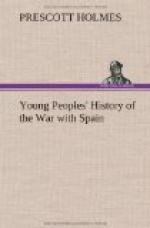Before the Cubans began to fight the Spaniards, in 1895, Cardenas was a very pleasant city in which to live. So many Americans who had business interests in Cuba lived there, that it was frequently spoken of as the American city. Like Matanzas, it was the shipping point for a great sugar-growing district, and one of the finest sugar plantations in Cuba was in the vicinity of the city. The bay used to be a famous resort for pirates, but they were exterminated a great many years ago by war vessels of the United States. Now I will tell you the story of the Winslow.
The blockading vessels off Cardenas were the Machias, the Wilmington and the Hudson. It was determined to enter the inner harbor and attack three small gunboats which were known to be there. While preparations for the attack were being made, the Winslow came in from off Matanzas, for coal, and was given a place in the attacking force. The Winslow, Wilmington and Hudson entered the inner harbor through a small channel to the eastward, near Blanco Cay. The Winslow went in closer than the others, and almost before her plucky commander knew it, the fire of the Spanish gunboats and of some shore batteries was concentrated on this frail craft.
The Winslow was a torpedo-boat, and this class of vessels do not have very thick sides or carry heavy guns. They are very fast and the powerful torpedoes they carry can destroy the largest and heaviest ship afloat.
The Winslow returned the Spanish fire splendidly, but at last a shot crashed into her bow and disabled her boiler. Another tore away her steering gear; and then she rolled helplessly while the Spaniards made her a target for every gun they could bring to bear. Seeing her helpless condition, the Hudson came to her assistance and tried to get a line on board. After awhile she succeeded, but when she attempted to tow her away the line parted. She made a second attempt, but just at the instant the little group on the Winslow caught the line, a shell burst in their very faces. Several of the crew, including the commander of the Winslow, were wounded, and Ensign Bagley and four seamen were instantly killed. There was scarcely a man left on the torpedo-boat to make the line fast, but it was done at last, and the Hudson towed the shattered Winslow out of danger. It was a very brave thing that the officers and men of the Hudson did, and later they were thanked by Congress, and a medal of honor was presented to each of them.
I think you will be pleased to learn that the next day the Wilmington went into the harbor again, and with her big guns tore the forts and batteries to atoms, sank two gunboats and two other vessels, and burned a blockhouse.
[Illustration: Ensign Worth Bagley.]
Ensign Bagley, the first and the only line officer in the navy to fall in the war with Spain, was one of the most popular of young naval officers. While at the Academy at Annapolis he became known as an all-round athlete, but his greatest triumphs were on the foot-ball field. His record throughout his naval career was stainless, and the news of his death was received with sorrow by the people of the United States.




